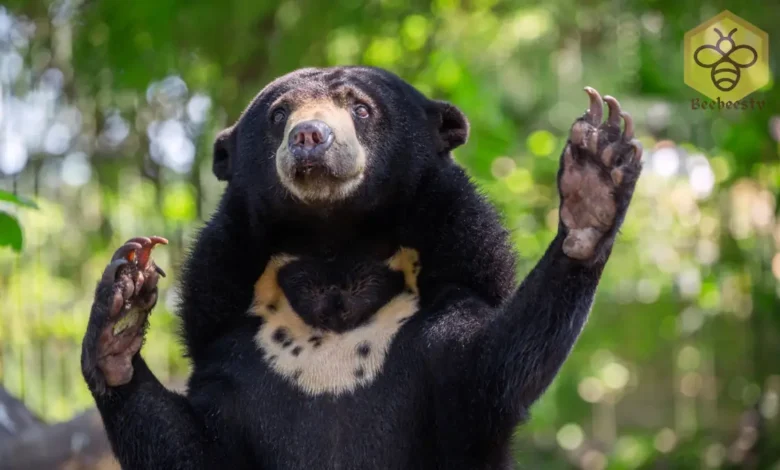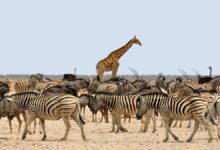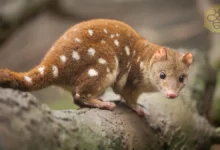Sun Bears: The world’s Smallest and most Vulnerable bear

Sun Bear: The Smallest Yet Fiercest Bear in the World
Sun Bear
The sun bear (Helarctos malayanus), the smallest of the world’s bear species, is often overshadowed by its larger relatives like polar bears and grizzly bears. Despite its smaller size, the sun bear boasts a remarkable set of characteristics and behaviors that make it one of the most unique and interesting animals in the bear family. Found in the tropical forests of Southeast Asia, the sun bear plays a crucial role in its ecosystem and is known for its striking chest markings and sharp claws.
Scientific Name
The scientific name of the sun bear is Helarctos malayanus.
Common Name
The sun bear is also known as the “honey bear,” due to its love for honey and beehives. The name “sun bear” refers to the golden or crescent-shaped patch of fur on its chest, which is said to resemble the rising sun.
Scientific Classification
| Kingdom | Animalia |
| Phylum | Chordata |
| Class | Mammalia |
| Order | Carnivora |
| Family | Ursidae |
| Genus | Helarctos |
| Species | H. malayanus |
Types of Sun Bears
While the sun bear is the only species in the Helarctos genus, there are some regional differences in terms of size and color that may vary depending on their geographic location. However, no distinct subspecies have been formally recognized.
Habitat
Sun bears are typically found in the tropical rainforests of Southeast Asia, particularly in countries such as:
- Malaysia
- Indonesia
- Thailand
- Vietnam
- Borneo and Sumatra
These bears are highly arboreal, spending a significant amount of their time in trees. The dense, humid forest provides them with ample food and shelter, though deforestation and habitat fragmentation are major threats to their survival.
Physical Characteristics
Sun bears may be small compared to other bear species, but they are built for survival in their environment. Key physical characteristics include:
- Size: Sun bears typically stand about 1.2 to 1.5 meters (4 to 5 feet) in length and weigh between 27 to 65 kg (60 to 145 lbs). Males tend to be slightly larger than females.
- Fur: Their short, sleek fur is usually jet black, though some individuals may have a reddish hue. The most distinguishing feature is the orange or white crescent marking on their chest.
- Claws: They have long, sharp claws that are perfectly suited for climbing trees and tearing open logs to find insects.
- Tongue: Their tongue can extend up to 20-25 cm (8-10 inches), making it incredibly efficient for extracting honey from beehives, earning them the nickname “honey bear.”
Diet
Sun bears are omnivores with a highly varied diet. They eat:
- Fruits such as figs, bananas, and coconuts
- Insects like termites, ants, and beetles
- Honey, which is a particular favorite
- Small vertebrates like birds and rodents
Their keen sense of smell helps them locate food, and their strong claws and long tongues allow them to access difficult-to-reach sources of nutrition. Sun bears play an important role in their habitat by dispersing seeds through their diet, which helps maintain forest health.
Predators and Threats
As one of the smallest bear species, sun bears face threats from natural predators, although adult sun bears have few enemies in the wild. Their main threats include:
- Humans: The biggest threat to sun bears comes from human activities. Deforestation, poaching, and illegal wildlife trade are all major factors contributing to their declining numbers.
- Tigers and Large Carnivores: While adult sun bears are generally safe from natural predators, young cubs may be vulnerable to attacks from tigers or large cats.
- Habitat Loss: As Southeast Asian forests are cleared for agriculture, palm oil plantations, and human settlement, sun bears lose their homes and sources of food.

Reproduction, Babies, and Lifespan
Sun bears have a relatively low reproductive rate, and their reproductive habits are not as well-studied as those of other bear species.
- Mating Season: Sun bears do not have a specific mating season and may reproduce year-round.
- Gestation Period: The gestation period lasts between 95 to 174 days, depending on environmental factors.
- Cubs: Females typically give birth to one or two cubs, which are born blind and completely dependent on their mother. Cubs stay with their mothers for about 18 months before becoming independent.
- Lifespan: In the wild, they can live up to 25 years, though in captivity, they have been known to live slightly longer.
Population
The population of sun bears has been declining rapidly over the past few decades. Although exact numbers are difficult to estimate due to their elusive nature, the International Union for Conservation of Nature (IUCN) lists the sun bear as “Vulnerable.” Habitat destruction, poaching for their gallbladders and paws (used in traditional medicine), and illegal pet trade are the primary drivers of their population decline.
Behavior and Lifestyle
Sun bears are solitary animals, unlike some of the more social bear species. They are primarily nocturnal, becoming most active at night when they forage for food. During the day, they often sleep in tree hollows or nests that they build high in the branches, using their strong claws and limbs to climb trees effortlessly.
- Territoriality: They are highly territorial and mark their areas by clawing tree trunks or rubbing their bodies against trees.
- Communication: They communicate using vocalizations such as growls, roars, and snuffles. They also use body language to express dominance or submission.
Ecological Role
Sun bears play an essential role in maintaining the health of tropical ecosystems. As omnivores, they help regulate insect populations and contribute to seed dispersal. By breaking open trees and digging for insects, they create microhabitats for other species. Their diet of fruit also helps with forest regeneration, as they spread seeds across large areas.
FAQs About Sun Bears
- Why are sun bears called “sun bears”?
Sun bears are named for the crescent-shaped marking on their chest, which is said to resemble the rising sun. - Are sun bears endangered?
They are listed as “Vulnerable” due to habitat loss, poaching, and the illegal wildlife trade. - What do sun bears eat?
Sun bears are omnivores, and their diet includes fruits, insects, small animals, and honey. - Where do sun bears live?
Sun bears live in the tropical rainforests of Southeast Asia, primarily in countries like Malaysia, Indonesia, and Thailand. - How long do sun bears live?
In the wild, sun bears live up to 25 years, though they may live longer in captivity.
Conclusion
The sun bear is an extraordinary species with unique physical traits, behaviors, and ecological importance. Despite its small size compared to other bear species, the sun bear has a significant impact on its environment and plays a vital role in maintaining the health of tropical rainforests. However, like many other wildlife species, it is facing severe threats from human activities, making conservation efforts crucial for its survival. Protecting the sun bear means safeguarding the biodiversity of its habitat and ensuring that this magnificent creature continues to thrive in the wild for generations to come.


